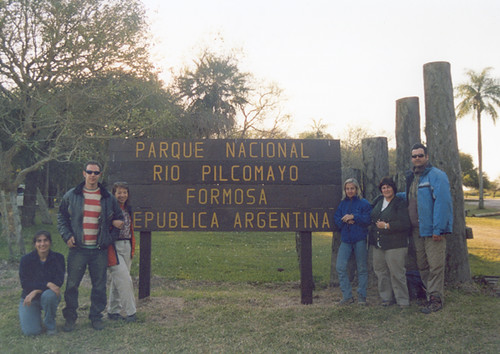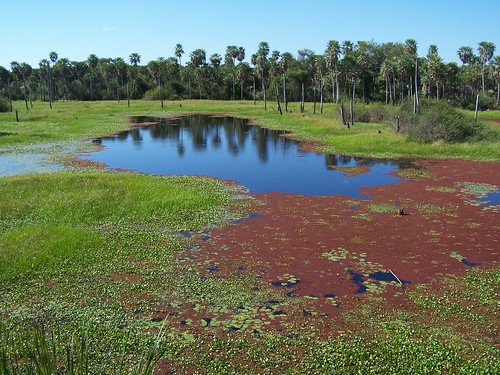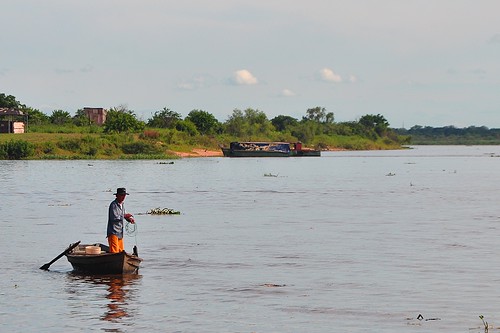
Rio Pilcomayo National Park, is a fascinating environmental mosaic which is concentrated 30 percent of bird species and 20 percent of mammal in the country, and maintains a close relationship with Aboriginal communities
When the place and everything that surrounded the place, ie, forest, forest, grassland, savanna bathed and when the 52,800 hectare were millions before today, and soon to say just a couple of centuries, the jaguar or jaguar ( jaguar, in Guarani), or American tiger, or uturunco, as it is called, was the kingpin of a vast region extending from northern Argentina to the very banks of the Black River. And more: the domain of this close relative of the Asian tiger and leopard Africa came to the southwestern United States. Thanks to its unique characteristics (Walker tireless, great swimmer, infallible predator and great capacity for adaptation), the largest feline in the Americas and the third largest in the world can live both in the Mohave Desert, California , as in the Amazon, open savannas in flooded areas or in mountainous regions in Bolivia and northern Argentina. Only two limits inhibit the jaguar: the man placed upon it by narrowing their domains, and nature, which allows expansion to no more than 2000 meters of altitude above sea level.

Declared a National Natural Monument in 2001, today the jaguar occupies only between 10 and 15 per cent of its original distribution in Argentina (estimated a population of just 250 copies in the country, and around 10,000 across the continent) . Its decline came with lightning speed. In the mid-nineteenth century lived in nearby marshes and lagoons of Buenos Aires. And the delta of the Parana was a safe haven (the city of Tigre, before Las Conchas, owes its name). Their exodus to the north is due to the persecution suffered by considerable danger for the people, for their valuable skin, its status in the big game trophy and alteration of their natural environment due to logging and farming.
Pilcomayo River is a park that moves by its history and its rugged beauty and harsh. This is a place that, by its nature, requires the person who visits to exert all possible patience. It takes time spotting wildlife and understand its geography. The history and nature go hand in hand and, in the words of his guards, knowing the past is the first step required to enjoy all that Pilcomayo River offers.
They are inhabited by cutting ant species, and among the sites visited by scientists and researchers.

Wildlife:
Biodiversity is considerable. In this role plays a wide variety of environments that the area provides habitat for wildlife. In this environmental mosaic have been recorded 295 bird species (equivalent to 30% of Argentina), 68 mammals, 25 amphibians and 31 reptiles. Storks, herons, Bigua, butterflies, mountain foxes, iguana over, alligators, pumas, toucans, piranhas, anacondas, tapirs, bull frogs, turtles and water snakes rattlesnake false, and big rattler curiyú, growing to 4 meters long. The hawk glider, pumas, ocelots, maned-wolf, the noisy carayá or howler monkey, mirikiná night of only sixteen inches tall and a queue of thirty, the anteater … And the jaguar.
Flora:
On the banks of the Pilcomayo River and abandoned their banks, many of which may again have water in the floods, gallery forest appears. Here are trees such as bay leaves, thorn-crowned and fig, very useful because many birds and bats eat fruit. As in any forest, vines and creepers occupy much of the forest mass. In the small islands of forest, formed by irregular patches of vegetation, dominated by white and red quebracho Chaco, urunday guayacán noted for its red foliage, the white and black locust, lapacho yellow and pink and teasel. In the plains with palm, the palms of caranday occupy a vast area. The locals take advantage of ripe fruit to make a fermented drink, and the head (fruit) are eaten raw or roasted. The leaves are used to make hats and screens and enclosures have been used for telephone poles and farm buildings. This palm can exceed 20 feet.
In the estuaries, marshes and lakes, soils are permanently flooded. Notable were the reeds, the jasmine bathed, the reeds, the daisy bathed and popularly called water bolt or arrow. Among the floating plants, water stand poppy, water hyacinth, water hyacinth, pond lilies and the water star or bloody.
Climate:
The park is located in a temperate subtropical climate zone. The average rainfall of 1200 mm annually and mean annual temperature is 23 ° C. In summer the temperatures can reach 40 ° C and winters are not exempt of days with freezing temperatures and frost.
Location:
Northeast of the province of Formosa. The northern boundary is provided by the Pilcomayo River and part of northwest lower Pilcomayo river called or south. The party is lying on the Pilcomayo border with the Republic of Paraguay. The southern and eastern boundaries are made up of ranches and farms of agricultural production. The nearest town is more important Clorinda, about 40 km. Formosa, the provincial capital, lies 150 km from the park.
How come?
From Formosa capital to the city of Clorinda, by National Route No. 11. From there, the national highway No. 86 to near the southern boundary of the park in the town of Naicker Neck. From this point, a local road will take you to the park after traveling about 4 miles. There is another entrance, near the town of Laguna Blanca. Detachment is the Poí Estero Park Rangers, which is also reached by Route 86. Admission to the park is free and the most favorable season to visit is from March to November.

Good Luck!
Leave a Reply
You must be logged in to post a comment.
Recent Comments